July 20, 2016 – Volume 18 #4: Nuclear-Free Dreaming
In This Issue
Flanigan’s Eco-Logic
Visiting Quebec, Friends, and Cities
Reconnecting with Michel in Montreal
The Walled City of Quebec
Power and Water from the North
Sweden Test First Catenary-Powered “Electric Roadway”
Energy Efficiency in the Cockpit
Lowline: New York’s Underground Park
Paris in the Lead on Mobility and Emissions
How Hot are LEDs?
Intersolar and EES in San Francisco
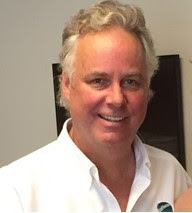
Flanigan’s Eco-Logic: Nuclear-Free Dreaming
Like Carlos Santana’s acceptance speech for the Year 2000 Grammy for Album of the year, this must be a dream. Please don’t wake me up…
It’s 1982… Burlington, Vermont. I’m active in the Clamshell Alliance. We’re pummeling Public Service Company of New Hampshire for its planned Seabrook Nuclear Power Plant. Governor Sununu is pummeling us. We had a dream of an end to nuclear power, an end to its gross risks. There must be a better way…. a cleaner, much safer way. Seabrook was built. And since then, Chernobyl, Fukushima…
Now the dream is real. California will soon be nuclear free. Pacific Gas and Electric Company announced this past month that it will close the Diablo Canyon Nuclear Power plant in 2025. It will not seek an operating license extension. Instead, it will shutter the plant, putting an end to nuclear in the Golden State. Southern California Edison elected to retire its San Onofre Nuclear Generating station (SONGS) in 2012.
Diablo was a contentious build. Understatement. Like Seabrook on the East Coast, Diablo was a lightening rod, a live wire. Situated directly on top of earthquake faults, the nuclear complex seemed like a risky venture to many citizens. But the plant was built, and today it pumps out nearly 9% of California’s power. So closure?
Clearly these electrons aren’t “too cheap to meter” as Richard Nixon had once professed that nuclear would be. In fact, PG&E believes that it can provide the same amount of energy at lower cost. Simple. And it will get this by investing in solar and wind. The announcement, one pundit stated, “is further evidence that the age of renewables has arrived.” We’re on a steep, carbon-free trajectory in California… 20% renewables by 2012, 33% by 2020, and 50% by 2030. This is very real, and nuclear is squeezed out.
The end of an era? Perhaps. Nuclear has continued to plague. The environmental community has been polarized by nuclear. Some say we need it. America’s 99 reactors produce about two-thirds of nation’s low-carbon energy, the other third provided by renewables. To some, nuclear is critical to powering our society while cutting GHGs and complying with global protocols for mitigation. To others like me, the Faustian Bargain that nuclear forces is simply unacceptable. Imagine having to relocate Manhattan given an accident at Indian Point.
Even with government insurance, nuclear is too expensive and can’t compete with innovative new sources. The economic reality is coming into focus, getting aligned with the environmental mandate of the era: Pacific Gas and Electric, announced that it would shut down Diablo Canyon and that it would replace the power with lower-cost, zero-carbon energy sources. This has prompted other states to consider following suit. Governor Cuomo in New York has expressed his interest in closing the Indian Point reactors, dangerously close to New York’s mega-metropolis. Am I dreaming?
Fast forward for fun. What will become of the closed nuclear sites? Might they become spiritual centers, modern-age vortexes of energy ala Sedona? Casinos for chain-smokers? Resorts complete with themed rooms, “the control room,” the “reactor vessel suite”… A site for weddings, cremations? We’re getting back some prime real estate from the nuclear era.
Levity, however, may be premature: What are we left with? Unlike all other forms of power production, a spent nuclear plant is hot with radiation and will be for years. San Onofre and Diablo will end up with casks of highly radioactive, spent fuel for decades. The reactors themselves are hot. These sites are dangerous. Of course we’ll need to address these before we bask in the nuclear-free reality.

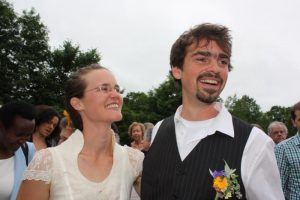
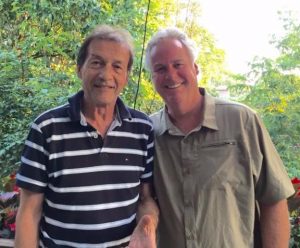 AirBNB in the old center of Montreal; hip loft, stone walls with huge beams. We wait at the sidewalk and soon the lights of an approaching car flash. Accomplished: A connection after many years. And it’s as if nothing much has happened. Michel Hannoyer had not changed a bit. He sneaks a peek in his rear view mirror and says it’s the same old Ted. We fall right back into an easy friendship.
AirBNB in the old center of Montreal; hip loft, stone walls with huge beams. We wait at the sidewalk and soon the lights of an approaching car flash. Accomplished: A connection after many years. And it’s as if nothing much has happened. Michel Hannoyer had not changed a bit. He sneaks a peek in his rear view mirror and says it’s the same old Ted. We fall right back into an easy friendship. It’s a three-hour drive up the St. Lawrence to Quebec City. This city is as close as you can get to visiting Europe in North America. Fully 95% of the city’s residents speak French. The old, picturesque city is walled with wonderful arched gates. You can walk 2.6 miles on top of the wall. Considered one of the most beautiful cities in the world, it is musical, and rated number one for romance. I hadn’t been there since I was on a high school field trip to the Canadian winter carnival. Distant memories of crazy Canadian teams crossing the iceberg-choked St. Lawrence River. We watched in awe as they scrambled and moved their boats from one iceberg to another. I’ll never forget the toboggan slide in front of the iconic Chateau Frontenac.
It’s a three-hour drive up the St. Lawrence to Quebec City. This city is as close as you can get to visiting Europe in North America. Fully 95% of the city’s residents speak French. The old, picturesque city is walled with wonderful arched gates. You can walk 2.6 miles on top of the wall. Considered one of the most beautiful cities in the world, it is musical, and rated number one for romance. I hadn’t been there since I was on a high school field trip to the Canadian winter carnival. Distant memories of crazy Canadian teams crossing the iceberg-choked St. Lawrence River. We watched in awe as they scrambled and moved their boats from one iceberg to another. I’ll never forget the toboggan slide in front of the iconic Chateau Frontenac. Quebec sits prominently over the Saint Lawrence Seaway, at a narrows in the seaway that connects the Great Lakes and the Atlantic. The Chateau Frontenac – originally built for Canadian Pacific railroad workers – commands a promontory position. A large promenade there features magnificent views of the river, the old part of the city, as well as the lively square near the Frontenac. We get lunch there.
Quebec sits prominently over the Saint Lawrence Seaway, at a narrows in the seaway that connects the Great Lakes and the Atlantic. The Chateau Frontenac – originally built for Canadian Pacific railroad workers – commands a promontory position. A large promenade there features magnificent views of the river, the old part of the city, as well as the lively square near the Frontenac. We get lunch there.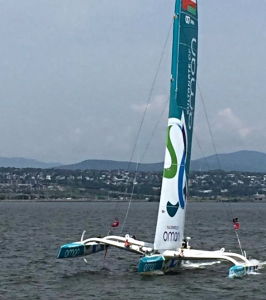 There’s quite a show for sailors… a brightly colored and clearly high-tech trimaran is making a spectacle in the river, jibing downwind before us. It’s preparing for the Transat sailing race that starts the next day and that goes from Quebec City to Saint-Malo, France. We learn that this high-tech, 40-meter multi-hull ship is sponsored by the Sultanate of Oman and comes highly anticipated. Can it beat the quite experienced field? This year’s race includes boats from Quebec, France, Spain, Germany, Sweden, and Oman. With crews of 3 – 12, they expect to arrive in French waters 8 – 15 days later. The race record is 7 days, 20 hours.
There’s quite a show for sailors… a brightly colored and clearly high-tech trimaran is making a spectacle in the river, jibing downwind before us. It’s preparing for the Transat sailing race that starts the next day and that goes from Quebec City to Saint-Malo, France. We learn that this high-tech, 40-meter multi-hull ship is sponsored by the Sultanate of Oman and comes highly anticipated. Can it beat the quite experienced field? This year’s race includes boats from Quebec, France, Spain, Germany, Sweden, and Oman. With crews of 3 – 12, they expect to arrive in French waters 8 – 15 days later. The race record is 7 days, 20 hours.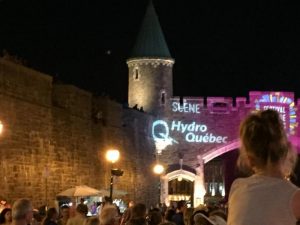 Quebec is a clean energy superpower. It runs on hydroelectricity. The province is water-rich. A half million lakes, plus mighty rivers, cover 21% of the land area of Quebec. It is the fourth largest hydroelectric producer in the world after China, Brazil, and the United States. Fully 96% of the power used in Quebec is hydro.
Quebec is a clean energy superpower. It runs on hydroelectricity. The province is water-rich. A half million lakes, plus mighty rivers, cover 21% of the land area of Quebec. It is the fourth largest hydroelectric producer in the world after China, Brazil, and the United States. Fully 96% of the power used in Quebec is hydro.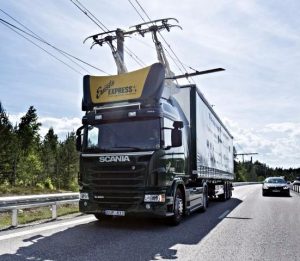

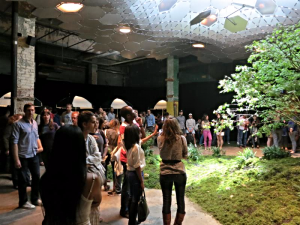
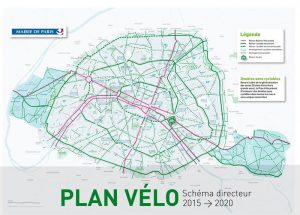
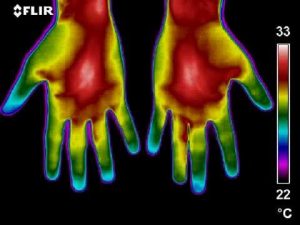 LEDs don’t produce heat? Is this fact or fiction” Answer: Light Emitting Diode lights do not get hot enough to burn a person or melt a surface. In fact, an LED bulb that has been on for days can be unscrewed with bare hands.
LEDs don’t produce heat? Is this fact or fiction” Answer: Light Emitting Diode lights do not get hot enough to burn a person or melt a surface. In fact, an LED bulb that has been on for days can be unscrewed with bare hands.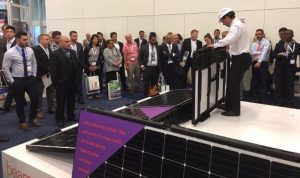
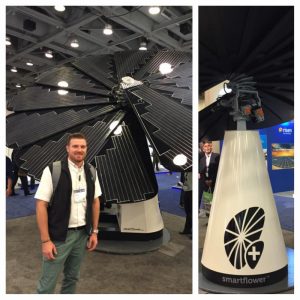 The Intersolar/EES conference and expo had about 550 vendors and 18,000 attendees, occupying all three floors of the Moscone Center West. The “Smartflower” really stood out from the crowd. The new Austrian invention got a plug (via video) from the former Governator himself, Arnold Schwarzenegger. The 2.51 kW of “solar pedals” open up in the morning, follows the sun throughout the day and closes at night. The standard 2-axis tracking allows the system to produce 5,880 kWh annually (when installed in the Southern California region). The opening and closing cleans the array with soft bristle brushes on each pedal and it will close itself automatically in high winds. With six colors to choose from and a cost of $16,900, you may see them coming to a yard in your neighborhood soon.
The Intersolar/EES conference and expo had about 550 vendors and 18,000 attendees, occupying all three floors of the Moscone Center West. The “Smartflower” really stood out from the crowd. The new Austrian invention got a plug (via video) from the former Governator himself, Arnold Schwarzenegger. The 2.51 kW of “solar pedals” open up in the morning, follows the sun throughout the day and closes at night. The standard 2-axis tracking allows the system to produce 5,880 kWh annually (when installed in the Southern California region). The opening and closing cleans the array with soft bristle brushes on each pedal and it will close itself automatically in high winds. With six colors to choose from and a cost of $16,900, you may see them coming to a yard in your neighborhood soon.